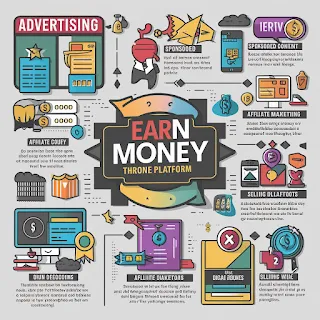Earning money from your website involves several strategies that leverage your site’s content, audience, and traffic.
1. Affiliate Marketing
Promote Products or Services:
- Partner with companies and promote their products or services on your site. Use unique affiliate links to track referrals.
Earn Commissions:
- You earn a commission for every sale or lead generated through your affiliate links.
Example:
- If you have a tech blog, you might promote gadgets and include affiliate links to online stores.
2. Display Advertising
Google AdSense:
- Sign up for Google AdSense to display contextual ads on your website. You earn money based on clicks (PPC) or impressions (CPM).
Direct Ad Sales:
- Sell ad space directly to businesses or use ad networks like MediaVine or AdThrive if your site meets their traffic criteria.
Example:
- A travel blog might display ads for travel gear or destination promotions.
3. Sponsored Content
Sponsored Posts:
- Collaborate with brands to write and publish sponsored posts. Charge a fee for featuring their products or services.
Sponsored Reviews:
- Write and publish reviews of products or services, often in exchange for payment or free products.
Example:
- A beauty blog might feature sponsored posts about new skincare products.
4. Sell Digital Products
E-books:
- Write and sell e-books related to your niche. These can be instructional guides, how-to books, or industry insights.
Courses and Webinars:
- Create and sell online courses or host webinars on topics relevant to your audience.
Printables:
- Offer downloadable resources like templates, planners, or worksheets for sale.
Example:
- A cooking blog could sell recipe e-books or meal planning guides.
5. Offer Services
Consulting or Coaching:
- Provide consulting or coaching services based on your expertise (e.g., business consulting, fitness coaching).
Freelance Work:
- Use your website to showcase your skills and attract freelance opportunities (e.g., writing, design, marketing).
Example:
- A marketing blog could offer digital marketing consulting services.
6. Memberships and Subscriptions
Premium Content:
- Create a membership area with exclusive content, resources, or features available only to paying subscribers.
Subscription Models:
- Offer a subscription model where users pay for access to premium content or tools.
Example:
- A news website might offer premium articles or in-depth reports for subscribers.
7. Create and Sell Merchandise
Branded Merchandise:
- Design and sell merchandise related to your brand or niche, such as T-shirts, mugs, or tote bags.
Online Stores:
- Use platforms like Shopify, WooCommerce, or Etsy to set up an online store for your merchandise.
Example:
- A blog about graphic design might sell branded design tools or art prints.
8. Donations and Crowdfunding
Donation Buttons:
- Add donation buttons to your site using platforms like PayPal or Buy Me a Coffee to receive support from readers.
Crowdfunding Campaigns:
- Use crowdfunding platforms like Patreon or Kickstarter to fund specific projects or ongoing content creation.
Example:
- A niche content creator might use Patreon to receive support from fans and offer exclusive content in return.
9. Email Marketing
Promote Products or Services:
- Use your email list to promote affiliate products, digital products, or services.
Sponsored Emails:
- Offer sponsorship opportunities in your email newsletters to promote products or services to your subscribers.
Example:
- A health blog could promote wellness products or courses through email marketing.
10. Sell Ad Space Directly
Contact Advertisers:
- Reach out to companies and offer to sell ad space directly on your website.
Create Media Kits:
- Develop a media kit with details about your audience, traffic, and ad rates to attract potential advertisers.
Example:
- A tech website might sell ad space to tech companies or gadget manufacturers.
Steps to Get Started
Choose Monetization Strategies:
- Select the monetization methods that best align with your website’s niche and audience.
Implement Strategies:
- Set up and integrate the chosen monetization methods on your site.
Monitor Performance:
- Use analytics tools to track the performance of your monetization strategies and make data-driven adjustments.
Optimize and Adjust:
- Continuously optimize your strategies based on performance data and feedback.
Diversify Income Streams:
- Explore multiple monetization methods to diversify your income and reduce reliance on a single source.
By leveraging these strategies and continuously improving your site’s content and user experience, you can effectively monetize your website and generate revenue.

Comments
Post a Comment